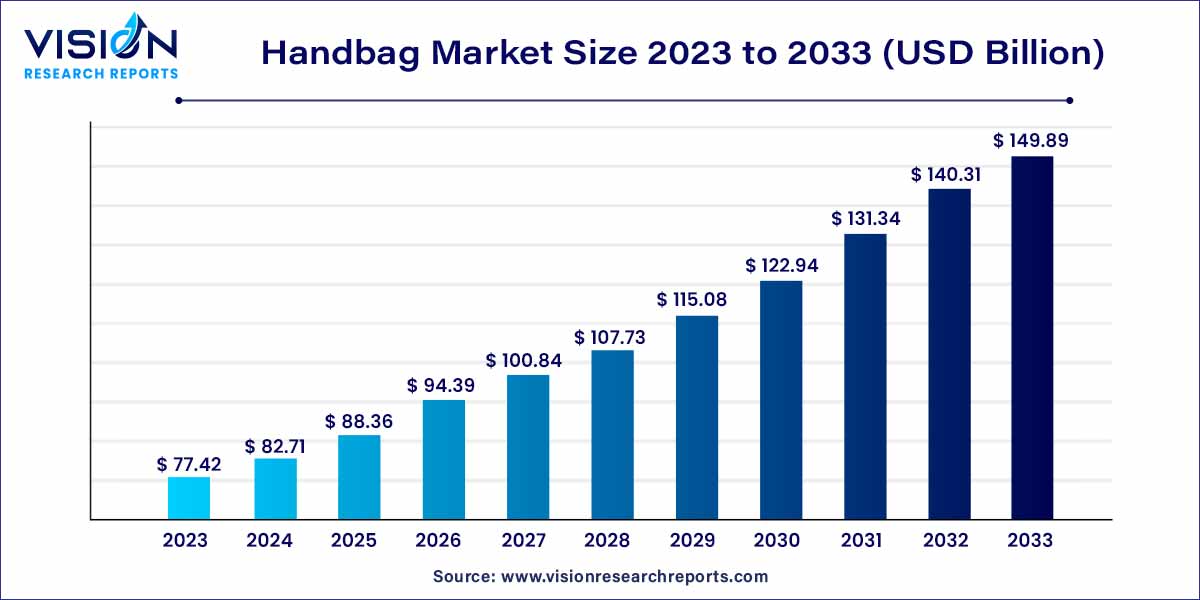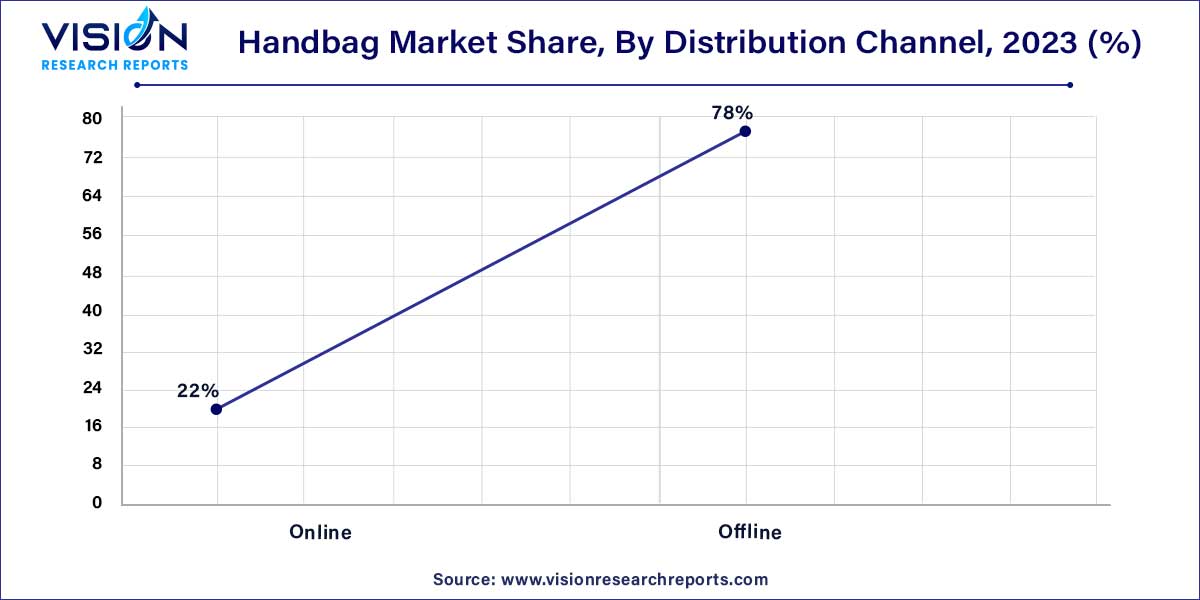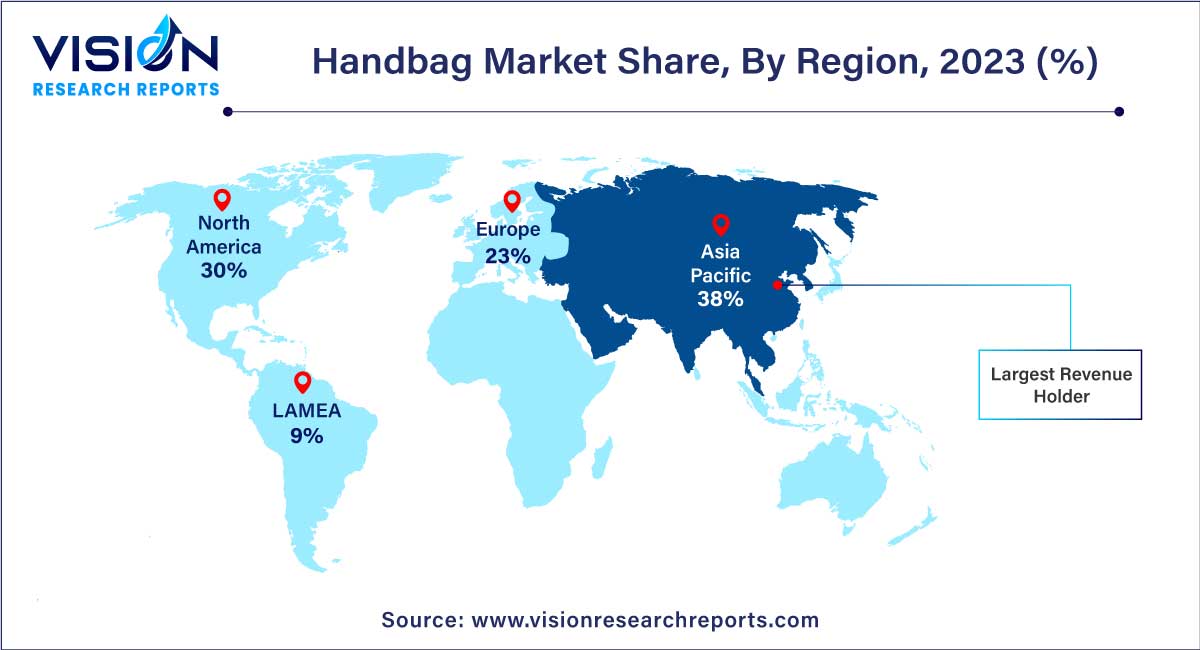The global handbag market was surpassed at USD 77.42 billion in 2023 and is expected to hit around USD 149.89 billion by 2033, growing at a CAGR of 6.83% from 2024 to 2033. The handbag market in the United States was accounted for USD 16.4 billion in 2023.

The handbag market, a cornerstone of the fashion industry, is a dynamic ecosystem shaped by evolving consumer preferences, innovative designs, and global fashion trends. As a quintessential accessory transcending mere utility, handbags have become a canvas for self-expression, reflecting individual style, status, and cultural influences.
The growth of the handbag market is propelled by a confluence of factors that collectively contribute to its expanding trajectory. One of the primary drivers is the increasing disposable income among consumers, affording them the capacity to invest in fashion accessories. Additionally, evolving fashion sensibilities and a growing emphasis on personal style contribute to sustained demand. The market's resilience is further underscored by its ability to adapt to economic fluctuations, ensuring consistent growth. As consumers become more conscious of sustainable practices, the integration of eco-friendly materials in handbag production serves as another growth catalyst. Furthermore, technological advancements, such as the incorporation of smart features, appeal to a tech-savvy consumer base. The dynamic interplay between traditional retail and the rise of e-commerce platforms also plays a pivotal role, providing consumers with convenient access and diverse choices. This amalgamation of economic, cultural, and technological factors positions the handbag market on a trajectory of continuous expansion.
| Report Coverage | Details |
| Market Revenue by 2033 | USD 149.89 billion |
| Growth Rate from 2024 to 2033 | CAGR of 6.83% |
| Revenue Share of Asia Pacific in 2023 | 38% |
| CAGR of North America from 2024 to 2033 | 5.48% |
| Base Year | 2023 |
| Forecast Period | 2024 to 2033 |
| Market Analysis (Terms Used) | Value (US$ Million/Billion) or (Volume/Units) |
Based on raw material, the leather handbag segment held the largest market share of 57% in 2023. Growing consumer preference for luxury goods and accessories is a major factor driving the demand for leather handbags. Leather is the primary raw material for luxury handbags and accessories. Rising consumer spending on luxury items in developed and developing economies can be attributed to the growing number of working women, who are increasingly willing to invest in leather handbags to create a versatile wardrobe collection. The rise in people’s discretionary income is also expected to create the demand for leather goods in developing countries like Thailand, Egypt, UAE, Saudi Arabia, and India. The demand for leather handbags is also supported by the advent of online shopping, particularly in Asia Pacific.
The fabric handbag segment is projected to grow at a CAGR of 5.85% from 2024 to 2033. Fabric handbags include bags made of cotton, silk, canvas, velvet, jute, and nylon. Key players in the market are investing in developing innovative raw materials to create handbags with different textures and appearances. Concerns regarding sustainability are encouraging players to adopt natural fibers like jute and cotton. Several retailers and supermarkets are increasingly using cotton tote and jute bags to reduce the use of single-use plastic.
In terms of product, the Tote bag segment contributed the largest market share of 42% in 2023. Tote bags are multi-purpose bags that can be used for a variety of tasks. Tote bags are popular among consumers due to their size and material. Tote bags are larger than other types of purses. These bags make it easier for consumers to carry essentials to offices, universities, and other places. The rising influence of Korean fashion and aesthetics among younger consumers is also driving the sale of tote bags. In addition, the stylish nature of totes helps consumers make a style statement on formal occasions.
The satchel bags market is expected to grow at a CAGR of 8.18% during forecast period. Satchel bags are available in different sizes from mid to large sizes with a flat bottom and two short handles. The bag can be worn either diagonally across the body or can be hung on the side. Satchel bags are versatile bags, which can be used by both men and women. These bags are gaining preference among consumers as they are useful for carrying multiple everyday work items like tablets, wallets, and laptops. The pandemic haltered the demand for satchel bags owing to work-from-home orders. In March 2021, the shopping platform Lyst, in its Year in Fashion Report, revealed that at the end of 2020, Telfar depicted a 270% week-on-week rise for its satchel bags and other handbags since August 2020.
In terms of distribution channel, the online distribution channel segment is projected to grow at the fastest CAGR of 8.68% over the forecast period owing to the rising popularity of e-commerce and social media channels. Younger consumers increasingly prefer online shopping owing to the digitalization of services. Companies operating in the market are constantly improving customer databases and digital stores to cater to a larger set of consumers. They are also utilizing social media platforms such as WeChat, Pinterest, Instagram, Twitter, and Sina Weibo as a way of communicating with customers to increase traffic for both online and offline distribution channels.

For instance, Capri Holdings, owner of leading brands like Michael Kors, Versace, and Jimmy Choo, has been expanding its global retail footprint by accelerating its omnichannel and e-commerce development. Companies such as Coach and Kate Spade have informational websites in China, Malaysia, Singapore, Taiwan, and Hong Kong to reach their consumers in Asia Pacific.
The offline distribution channel held the largest market share of 78% in 2023. The offline distribution channel for handbags includes department stores, specialty stores, and other retail stores. Consumers prefer offline stores as they offer a wide product variety with better convenience and accessibility than online stores. Leading handbag makers are partnering with wholesale stores like Macy’s, Bloomingdale’s, and Saks Fifth Avenue in the U.S. and Selfridges, Printemps, and Galeries Lafayette in Europe. Such collaborations help in accessing a larger customer base. Companies are also investing in larger spaces, along with decorative items, flooring, and wall casings, to attract consumers and increase footfall and sales via offline channels.
Asia Pacific dominated the market with a revenue share of 38% in 2023. The rise in consumer buying power, combined with the increase in online shopping portals, has fueled the demand for handbags across Asia Pacific. Growing fashion consciousness and spending on personal items and accessories have also been observed to be major factors driving the market growth. For instance, according to data released by Net-a-Porter in May 2020, the sales of handbags in Asia Pacific saw a strong growth of 261% compared to 2019.

In addition, China has seen exponential growth in terms of economic development and household consumption of consumer goods during the last decade. The rise in sales of luxury goods in China is expected to fuel the demand for handbags.
However, the North America handbag industry is expected to grow at a CAGR of 5.48% from 2024 to 2033. The growing influence of the fashion industry over a wider population and increased discretionary spending are expected to fuel the demand for handbags in the North America region. For instance, according to the data released by Trading Economics in July 2023, disposable personal income in the U.S. increased from USD 19,873.52 billion in May 2023 to USD 19,941.02 billion in June 2023.
Furthermore, clearance sales and Black Friday deals are popular in the U.S., with women, in particular, purchasing accessories like purses. During these events, international suppliers in the North America market see a boost in sales. Therefore, the consistent appeal of accessories is expected to drive market growth over the forecast period.
By Raw Material
By Product
By Distribution Channel
By Region
Chapter 1. Introduction
1.1. Research Objective
1.2. Scope of the Study
1.3. Definition
Chapter 2. Research Methodology
2.1. Research Approach
2.2. Data Sources
2.3. Assumptions & Limitations
Chapter 3. Executive Summary
3.1. Market Snapshot
Chapter 4. Market Variables and Scope
4.1. Introduction
4.2. Market Classification and Scope
4.3. Industry Value Chain Analysis
4.3.1. Raw Material Procurement Analysis
4.3.2. Sales and Distribution Raw Material Analysis
4.3.3. Downstream Buyer Analysis
Chapter 5. COVID 19 Impact on Handbag Market
5.1. COVID-19 Landscape: Handbag Industry Impact
5.2. COVID 19 - Impact Assessment for the Industry
5.3. COVID 19 Impact: Global Major Government Policy
5.4. Market Trends and Opportunities in the COVID-19 Landscape
Chapter 6. Market Dynamics Analysis and Trends
6.1. Market Dynamics
6.1.1. Market Drivers
6.1.2. Market Restraints
6.1.3. Market Opportunities
6.2. Porter’s Five Forces Analysis
6.2.1. Bargaining power of suppliers
6.2.2. Bargaining power of buyers
6.2.3. Threat of substitute
6.2.4. Threat of new entrants
6.2.5. Degree of competition
Chapter 7. Competitive Landscape
7.1.1. Company Market Share/Positioning Analysis
7.1.2. Key Strategies Adopted by Players
7.1.3. Vendor Landscape
7.1.3.1. List of Suppliers
7.1.3.2. List of Buyers
Chapter 8. Global Handbag Market, By Raw Material
8.1. Handbag Market, by Raw Material, 2024-2033
8.1.1 Leather
8.1.1.1. Market Revenue and Forecast (2021-2033)
8.1.2. Fabric
8.1.2.1. Market Revenue and Forecast (2021-2033)
8.1.3. Others
8.1.3.1. Market Revenue and Forecast (2021-2033)
Chapter 9. Global Handbag Market, By Product
9.1. Handbag Market, by Product, 2024-2033
9.1.1. Tote Bag
9.1.1.1. Market Revenue and Forecast (2021-2033)
9.1.2. Clutch
9.1.2.1. Market Revenue and Forecast (2021-2033)
9.1.3. Satchel
9.1.3.1. Market Revenue and Forecast (2021-2033)
9.1.4. Others
9.1.4.1. Market Revenue and Forecast (2021-2033)
Chapter 10. Global Handbag Market, By Distribution Channel
10.1. Handbag Market, by Distribution Channel, 2024-2033
10.1.1. Online
10.1.1.1. Market Revenue and Forecast (2021-2033)
10.1.2. Offline
10.1.2.1. Market Revenue and Forecast (2021-2033)
Chapter 11. Global Handbag Market, Regional Estimates and Trend Forecast
11.1. North America
11.1.1. Market Revenue and Forecast, by Raw Material (2021-2033)
11.1.2. Market Revenue and Forecast, by Product (2021-2033)
11.1.3. Market Revenue and Forecast, by Distribution Channel (2021-2033)
11.1.4. U.S.
11.1.4.1. Market Revenue and Forecast, by Raw Material (2021-2033)
11.1.4.2. Market Revenue and Forecast, by Product (2021-2033)
11.1.4.3. Market Revenue and Forecast, by Distribution Channel (2021-2033)
11.1.5. Rest of North America
11.1.5.1. Market Revenue and Forecast, by Raw Material (2021-2033)
11.1.5.2. Market Revenue and Forecast, by Product (2021-2033)
11.1.5.3. Market Revenue and Forecast, by Distribution Channel (2021-2033)
11.2. Europe
11.2.1. Market Revenue and Forecast, by Raw Material (2021-2033)
11.2.2. Market Revenue and Forecast, by Product (2021-2033)
11.2.3. Market Revenue and Forecast, by Distribution Channel (2021-2033)
11.2.4. UK
11.2.4.1. Market Revenue and Forecast, by Raw Material (2021-2033)
11.2.4.2. Market Revenue and Forecast, by Product (2021-2033)
11.2.4.3. Market Revenue and Forecast, by Distribution Channel (2021-2033)
11.2.5. Germany
11.2.5.1. Market Revenue and Forecast, by Raw Material (2021-2033)
11.2.5.2. Market Revenue and Forecast, by Product (2021-2033)
11.2.5.3. Market Revenue and Forecast, by Distribution Channel (2021-2033)
11.2.6. France
11.2.6.1. Market Revenue and Forecast, by Raw Material (2021-2033)
11.2.6.2. Market Revenue and Forecast, by Product (2021-2033)
11.2.6.3. Market Revenue and Forecast, by Distribution Channel (2021-2033)
11.2.7. Rest of Europe
11.2.7.1. Market Revenue and Forecast, by Raw Material (2021-2033)
11.2.7.2. Market Revenue and Forecast, by Product (2021-2033)
11.2.7.3. Market Revenue and Forecast, by Distribution Channel (2021-2033)
11.3. APAC
11.3.1. Market Revenue and Forecast, by Raw Material (2021-2033)
11.3.2. Market Revenue and Forecast, by Product (2021-2033)
11.3.3. Market Revenue and Forecast, by Distribution Channel (2021-2033)
11.3.4. India
11.3.4.1. Market Revenue and Forecast, by Raw Material (2021-2033)
11.3.4.2. Market Revenue and Forecast, by Product (2021-2033)
11.3.4.3. Market Revenue and Forecast, by Distribution Channel (2021-2033)
11.3.5. China
11.3.5.1. Market Revenue and Forecast, by Raw Material (2021-2033)
11.3.5.2. Market Revenue and Forecast, by Product (2021-2033)
11.3.5.3. Market Revenue and Forecast, by Distribution Channel (2021-2033)
11.3.6. Japan
11.3.6.1. Market Revenue and Forecast, by Raw Material (2021-2033)
11.3.6.2. Market Revenue and Forecast, by Product (2021-2033)
11.3.6.3. Market Revenue and Forecast, by Distribution Channel (2021-2033)
11.3.7. Rest of APAC
11.3.7.1. Market Revenue and Forecast, by Raw Material (2021-2033)
11.3.7.2. Market Revenue and Forecast, by Product (2021-2033)
11.3.7.3. Market Revenue and Forecast, by Distribution Channel (2021-2033)
11.4. MEA
11.4.1. Market Revenue and Forecast, by Raw Material (2021-2033)
11.4.2. Market Revenue and Forecast, by Product (2021-2033)
11.4.3. Market Revenue and Forecast, by Distribution Channel (2021-2033)
11.4.4. GCC
11.4.4.1. Market Revenue and Forecast, by Raw Material (2021-2033)
11.4.4.2. Market Revenue and Forecast, by Product (2021-2033)
11.4.4.3. Market Revenue and Forecast, by Distribution Channel (2021-2033)
11.4.5. North Africa
11.4.5.1. Market Revenue and Forecast, by Raw Material (2021-2033)
11.4.5.2. Market Revenue and Forecast, by Product (2021-2033)
11.4.5.3. Market Revenue and Forecast, by Distribution Channel (2021-2033)
11.4.6. South Africa
11.4.6.1. Market Revenue and Forecast, by Raw Material (2021-2033)
11.4.6.2. Market Revenue and Forecast, by Product (2021-2033)
11.4.6.3. Market Revenue and Forecast, by Distribution Channel (2021-2033)
11.4.7. Rest of MEA
11.4.7.1. Market Revenue and Forecast, by Raw Material (2021-2033)
11.4.7.2. Market Revenue and Forecast, by Product (2021-2033)
11.4.7.3. Market Revenue and Forecast, by Distribution Channel (2021-2033)
11.5. Latin America
11.5.1. Market Revenue and Forecast, by Raw Material (2021-2033)
11.5.2. Market Revenue and Forecast, by Product (2021-2033)
11.5.3. Market Revenue and Forecast, by Distribution Channel (2021-2033)
11.5.4. Brazil
11.5.4.1. Market Revenue and Forecast, by Raw Material (2021-2033)
11.5.4.2. Market Revenue and Forecast, by Product (2021-2033)
11.5.4.3. Market Revenue and Forecast, by Distribution Channel (2021-2033)
11.5.5. Rest of LATAM
11.5.5.1. Market Revenue and Forecast, by Raw Material (2021-2033)
11.5.5.2. Market Revenue and Forecast, by Product (2021-2033)
11.5.5.3. Market Revenue and Forecast, by Distribution Channel (2021-2033)
Chapter 12. Company Profiles
12.1. Louis Vuitton.
12.1.1. Company Overview
12.1.2. Product Offerings
12.1.3. Financial Performance
12.1.4. Recent Initiatives
12.2. Hermès International S.A.
12.2.1. Company Overview
12.2.2. Product Offerings
12.2.3. Financial Performance
12.2.4. Recent Initiatives
12.3. Michael Kors.
12.3.1. Company Overview
12.3.2. Product Offerings
12.3.3. Financial Performance
12.3.4. Recent Initiatives
12.4. Fossil Group, Inc.
12.4.1. Company Overview
12.4.2. Product Offerings
12.4.3. Financial Performance
12.4.4. Recent Initiatives
12.5. Guccio Gucci S.p.A.
12.5.1. Company Overview
12.5.2. Product Offerings
12.5.3. Financial Performance
12.5.4. Recent Initiatives
12.6. Prada S.p.A.
12.6.1. Company Overview
12.6.2. Product Offerings
12.6.3. Financial Performance
12.6.4. Recent Initiatives
12.7. Burberry Group Plc.
12.7.1. Company Overview
12.7.2. Product Offerings
12.7.3. Financial Performance
12.7.4. Recent Initiatives
12.8. Tapestry, Inc.
12.8.1. Company Overview
12.8.2. Product Offerings
12.8.3. Financial Performance
12.8.4. Recent Initiatives
12.9. Chanel.
12.9.1. Company Overview
12.9.2. Product Offerings
12.9.3. Financial Performance
12.9.4. Recent Initiatives
12.10. Compagnie Financière Richemont SA
12.10.1. Company Overview
12.10.2. Product Offerings
12.10.3. Financial Performance
12.10.4. Recent Initiatives
Chapter 13. Research Methodology
13.1. Primary Research
13.2. Secondary Research
13.3. Assumptions
Chapter 14. Appendix
14.1. About Us
14.2. Glossary of Terms
 Cross-segment Market Size and Analysis for
Mentioned Segments
Cross-segment Market Size and Analysis for
Mentioned Segments
 Additional Company Profiles (Upto 5 With No Cost)
Additional Company Profiles (Upto 5 With No Cost)
 Additional Countries (Apart From Mentioned Countries)
Additional Countries (Apart From Mentioned Countries)
 Country/Region-specific Report
Country/Region-specific Report
 Go To Market Strategy
Go To Market Strategy
 Region Specific Market Dynamics
Region Specific Market Dynamics Region Level Market Share
Region Level Market Share Import Export Analysis
Import Export Analysis Production Analysis
Production Analysis Others
Others